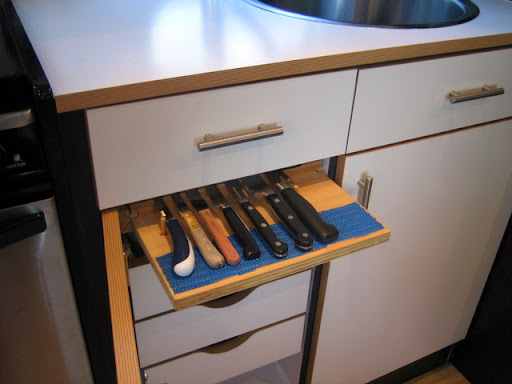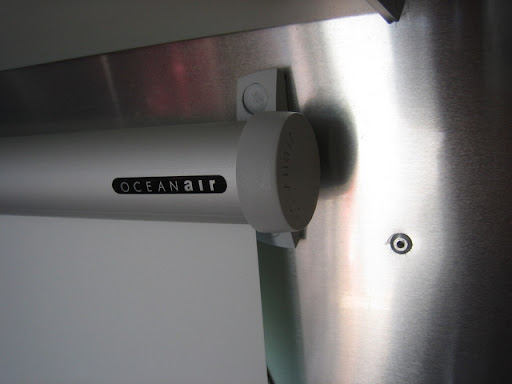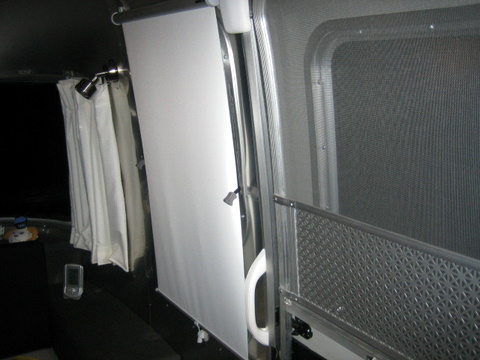We heard about the Oxygenic Shower Head, with almost cultish praise, at 2008's Easter Rally in St Augustine and again at the WBCCI International Rally in Bozeman, MT the same year. In a way, though, it seemed a little like promoting something as mundane as a toilet tank fill valve. What are you going to do, stand in your neighbor's bathroom and test his plumbing? So we didn't test it. And we were a little skeptical about the fantastic praise these water-saving shower heads generate.
But being the romantic, Jim happened upon one on sale and bought it for Deb's birthday. (What a romantic, right?) Then he couldn't wait for her birthday and he gave it to both of us during an extended caravan. Well, it is fantastic, does greatly improve the water velocity, feels great, and could save water. We laugh about the last claim because while it does reduce the flow rate even while increasing the spray sensation, it feels so good we want to stay in the shower longer. Well, we can afford that luxury when we have full hook-ups and when we are dry-camping we can benefit from the new shower head's reduced flow rate. We highly recommend this product. Ours is a Chrome #130-XLF25, and we paid $45 including free shipping from Amazon.com. Camping World stores often have these on the racks at reasonable prices, too.
UPDATE Apr 2012, A couple of years later we found a nice in-line flow control for the shower head. It works more easily than the one in our Oxygenics, and we've notice some of the Oxygenics heads don't even have flow control. No problem, find one at your local RV supply store for $7-10.
Return to top
I6. Breadboard knife rack under the new drawer:
 While shopping for a source for the RV-style drawer guides we came upon guides for a 3/4 inch thick sliding breadboard. We ordered these for approx $10 including shipping (also from http://www.houckind.com/ model 120BB)at the same time to install two inches below the new drawer in an almost four inch space above the tallest existing drawer. We installed a magnetic knife holder on a piece of birch plywood and can now hold all but one of our eight kitchen knives. Yeah, only eight. We had at least twice as many in our house and thinned the collection down to the few we knew we had to have. These are an eight inch serrated bread knife, an eight inch carving knife, a six inch boning knife, a pair of four inch serrated tomato knives, and two paring knives. Only one knife doesn't fit on the new knife board and we use it daily, a very sharp serrated cheese cutter we store in its own sleeve.
While shopping for a source for the RV-style drawer guides we came upon guides for a 3/4 inch thick sliding breadboard. We ordered these for approx $10 including shipping (also from http://www.houckind.com/ model 120BB)at the same time to install two inches below the new drawer in an almost four inch space above the tallest existing drawer. We installed a magnetic knife holder on a piece of birch plywood and can now hold all but one of our eight kitchen knives. Yeah, only eight. We had at least twice as many in our house and thinned the collection down to the few we knew we had to have. These are an eight inch serrated bread knife, an eight inch carving knife, a six inch boning knife, a pair of four inch serrated tomato knives, and two paring knives. Only one knife doesn't fit on the new knife board and we use it daily, a very sharp serrated cheese cutter we store in its own sleeve.
Return to top
I7. Additional drawer directly beside the kitchen sink:
 A credit to Airstream Company has always been the optimal use of spaces in the camper. Sometimes though, we're willing to go even a little further. In our 2005 Airstream, we are delighted to have found a potential drawer space thirteen inches wide by sixteen inches long by four inches deep beside the galley sink. Jim cut the dead-front panel in line with the meeting edge for the cabinet doors immediately below. He added drawer pulls for the new drawer front and for the now-shorter dead-front, and attached rv-style guides (cost approx $10 including shipping from http://www.houckind.com/ model 950rv) and a drawer. The rv-style drawer guides prevent accidental opening while rolling down the road. The result is a drawer wide enough for a silverware organizer plus small boxes of plastic utensils at the sides and back of the organizer.
A credit to Airstream Company has always been the optimal use of spaces in the camper. Sometimes though, we're willing to go even a little further. In our 2005 Airstream, we are delighted to have found a potential drawer space thirteen inches wide by sixteen inches long by four inches deep beside the galley sink. Jim cut the dead-front panel in line with the meeting edge for the cabinet doors immediately below. He added drawer pulls for the new drawer front and for the now-shorter dead-front, and attached rv-style guides (cost approx $10 including shipping from http://www.houckind.com/ model 950rv) and a drawer. The rv-style drawer guides prevent accidental opening while rolling down the road. The result is a drawer wide enough for a silverware organizer plus small boxes of plastic utensils at the sides and back of the organizer.
Return to top
I8. Wilson Sleek cellular signal booster:
The Wilson Sleek improved our cellular signal inside the trailer. We use it primarily for our Verizon Mifi and sometimes for the iPhone when connectivity is especially poor and we need voice. It makes a real difference for us. The Sleek kit we bought isn't available, but other similar ones seem to be still. Ours has a 2" antenna (magnetic mount) for rooftop, a 12vdc power adapter, a glue-on wall mount, and clips to hold snugly against the pad several different sized hotspots or phones. Our biggest benefit is connectivity when we're staying in locations with poor cellular service. We also like having improved mobile wifi availability on towing days - the hotspot in it's cradle radiates fine up to the truck cab.
The hotspot stays in the trailer, plugged into 12 volt power. As we travel down the road the mifi changes towers without problems and provides us 2-way signal up to the truck cab. The passenger is able to use our iPads more easily and without having to keep up with where on the dash the hotspot will ride and see cellular antennas. Too, we get one to two bars better signal with the Wilson Sleek and its little roof-top antenna than we did with the hotspot sitting inside the aluminum-walled trailer. We paid around $140 for this in 2015, and would buy it again unless we found another model that was higher performing without being excessively expensive. This model was priced at around $180 in 2017. More info is available at Wilson Sleeks website
UPDATE 27Apr2018, A reader advised us April 2018 Wilson no longer offers the Sleek. The new unit lists at $350 according to Wilson's website on 27 Apr 2018. You can see this at Wilson RV cellular amplifiers website For much more and much smarter coverage on this issue I recommend you see Technomadia's excellent page at Technomadia's cellular boosters for RVs & Boats Overview page.


Return to top
I9. Outdoor Thermometer:
This provides us an easy-to-read outdoor temperature from inside the trailer. Attaches to the window exterior surface via a suction cup (we stow it inside before we tow.) We can see it through the trailer's heavily tinted window glass, it costs less than $10, and uses a small replaceable watch battery. Thanks to Jack White for showing us this in North Ft Myers a couple of years ago.
UPDATE:27Apr2018, Added photo.

Return to top
I10. Light in lower pantry:
We enjoy browsing IKEA occasionally. They started displaying and selling various LED strips for inside their drawer fronts. In 2014 they were selling a 12" strip with AAA batteries, and it automatically turned on and off when you operated a drawer or cabinet door. This allows us some automatic lighting in the small cabinet under Debbie's wardrobe, where we keep a few extra cans and bottles that won't fit in the pantry.The automatic LED lighting is just right to light up the space for 15 seconds before it shuts off.
Update Dec 31 2018, We cannot find the AAA-powered led light strips at IKEA. Probably responsible design for them, eliminating disposable batteries in this nice light. Now the similar lights at IKEA are powered by small 120vac transformers (wall-warts). We would still like it for this application but would have to figure out from where we'd get the 120vac since most of the trailer's wiring is 12vdc.
Return to top
I11. The OCEANair® hatch shades:


We installed these throughout the trailer. We think replacing the old vinyl roller shades with these hatch shades is one of the most attractive changes we've made. These shades fit closely to the wall of the trailer and most of them will tuck in under the lifting handles to hold the shade even snugger to the wall for better privacy. The OceanAir shades look so much better than the original vinyl roller shades -- Airstream Co seems to agree, they now install these on some of their models. We purchased our shades from Airstream while we were at Jackson Center September 2007 having other work done. Airstream had a window schematic for our model trailer with dimensions and part numbers. Their prices were far better than what we had found on the internet and no shipping. Jim installed them instead of paying Airstream hourly service rates. We reused some of the same holes from the original shades but where these didn't fit, we covered the old holes with rivets.
Return to top
I12. Olympian® Wave6® catalytic heater:


We had one motivation for adding a fourth heat mode in our Airstream. Two of the three heat sources (rooftop a/c heat strips; ceramic cube heater) require 110 volts (shore power) and the furnace requires a lot of battery for its fans. A catalytic heater burns propane, is extremely efficient (converts almost all the energy to heat), doesn't take a lot of space, is quiet, and uses NO battery or shore power. If we are camping without shore power this heater is great for daytime use -- it heats us wonderfully with radiant heat. It has a lighter (piezo) like a BBQ grill and three heat settings. We mounted it on a hinged plate on the end of the counter so it can be swiveled toward the dinette or the sofa. We like the warm radiant heat from our Olympian Wave6.
Funny thing -- we wondered if we should have considered a Wave 4, with its lower heat output. This Wave 6 was driving us outta here sometimes. Fall 2009 we dry camped alot in Washington and Idaho, often well above 2,000 feet and up to 6,000 feet. More recently, Winter 2014, we are traveling and camping in low 20s to 40s. The Wave 6 is just perfect, thank you. We run it on high or medium almost all the waking hours when it is below 50 F degrees outside and it keeps us very comfortable. So the Wave 6 is a great choice for us in our 25' trailer.
The downside of an unvented catalytic heater, and this is critically important to us, is it removes Oxygen from, and produces carbon monoxide into, our living space. We have to be very careful to adequately ventilate the camper whenever this heater is operating because the heater is unvented (note that you can purchase vented catalytic heaters instead.) We faithfully follow the manufacturer's recommendations for venting our camper whenever heating with this device. Until 2013 (when we added a low-wall intake vent,) we opened a window near the sofa and opened the rear fantastic fan a couple of inches, with fan "off." This creates a low to high fresh air current to refresh a portion of the interior air (See 2014 edit 2 paragraphs below.) We NEVER burn the catalytic heater when we are asleep, not even napping. We NEVER sleep with this heater on. Loss of oxygen is extremely dangerous -- you just fall asleep and don't wake up, ever.
edit 2/16/2010 -- we ran the Wave 6 all our waking hours (first time ever for such a long burn) one weekend while camped in a field in Orlando, FL, for Hamcation 2010. The weather was just crummy, rainy and cold all day. Opened a front window (before we had installed the Salem vent) and roof vent at opposite ends of the Airstream, and kept the heater on low the entire day. Wow, it was great to have heat! And, several days later as I edit this I'm on the sofa, just turned off the Olympics television coverage, and am enjoying the warm rays from the heater. Low setting is very comfortable, the trailer is 65 degrees but I am toasty.
See also on this page at the Salem vent sidewall ventilation near the floor ahead of the trailer's door. Really improved ventilation for the heater, oven and stove without resorting to opening windows for intake air. This has been a great solution for us. See more details see our blog article about installing the Salem vent. Also, see our web page with pictures about how the Wave 6 catalytic heater is mounted in our RV. The manufacturer's page is Salem vent
Return to top